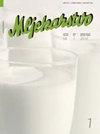Analysis of the kefir and koumiss microbiota with the focus on certain functional properties of selected lactic acid bacteria
IF 1.1
4区 农林科学
Q3 AGRICULTURE, DAIRY & ANIMAL SCIENCE
引用次数: 3
Abstract
The aim of this research was to determine the microbiota of commercial kefir, koumiss and homemade kefir samples using metagenomic analysis and compare some probiotic properties of lactic acid bacteria isolated from these beverages and Lactobacillus casei, used in yakult production. One koumiss, 5 commercially available kefir beverages with different brands, and 1 homemade kefir were used as samples. Microbial diversity of kefir and koumiss samples were determined by metagenomic analysis, targeting V1-V2 region of 16S rRNA gene. Streptococcus thermophilus and Lactococcus lactis were detected as dominant in direct DNA isolation from commercially available kefir beverages. Lc. lactis and Leuconostoc mesenteroides were dominant in MRS agars, and Lc. lactis were dominant in M17 agars. In kefir beverages produced by kefir grains, Lb. kefiranofaciens was determined as the dominant bacteria. Lb. kefiri and Enterococcus durans were found dominant in MRS and M17 agars respectively. Lb. kefiranofaciens, Lb. kefiri, and Str. thermophilus were the dominant bacterias of koumiss beverages. Microorganisms isolated from kefir and koumiss beverages were found to exhibit basic probiotic properties, similar to the lactic acid bacteria isolated from yakult. This research presented bacterial microflora and probiotic properties of lactic acid bacteria isolated from kefir and koumiss beverages consumed in Turkey.对开菲尔和酸奶菌群的分析,重点关注选定的乳酸菌的某些功能特性
本研究的目的是通过宏基因组分析确定商业开菲尔、koumis和自制开菲尔样品的微生物群,并比较从这些饮料中分离的乳酸菌和用于养乐多生产的干酪乳杆菌的一些益生菌特性。使用1个koumiss、5个不同品牌的市售开菲尔饮料和1个自制开菲尔作为样品。以16S rRNA基因V1-V2区为靶点,通过宏基因组分析测定了开菲尔和库密斯样品的微生物多样性。嗜热链球菌和乳酸乳球菌在从市售开菲尔饮料中直接分离DNA时被检测为占优势。乳酸菌和间质明串珠菌在MRS琼脂中占优势,乳酸菌在M17琼脂中占主导地位。在由开菲尔谷物生产的开菲尔饮料中,确定开菲尔酸杆菌为优势菌。在MRS和M17琼脂中分别发现克菲里蓝杆菌和硬脊肠球菌占优势。kefiranofaciens乳杆菌、kefiri乳杆菌和嗜热氏乳杆菌是komiss饮料的主要菌种。从开菲尔和koumiss饮料中分离的微生物被发现具有基本的益生菌特性,类似于从养乐多中分离的乳酸菌。这项研究介绍了从土耳其饮用的开菲尔和koumis饮料中分离出的乳酸菌的菌群和益生菌特性。
本文章由计算机程序翻译,如有差异,请以英文原文为准。
求助全文
约1分钟内获得全文
求助全文
来源期刊

Mljekarstvo
Agricultural and Biological Sciences-Animal Science and Zoology
CiteScore
1.90
自引率
41.70%
发文量
18
审稿时长
12 weeks
期刊介绍:
Mljekarstvo is an open access, peer-reviewed international quarterly scientific journal. The first issue was published in 1951, by the Croatian Dairy Operators'' Association (today: Croatian Dairy Union, publisher). In a paper at a Union conference held 28 October 1951 in Zagreb it was said: "Our desire is that this magazine does not meet the fate of its predecessors, but that it continues to reflect the creative efforts and to provide guidelines for the producers as well as all other operators employed in the dairy industry."
It is our pleasure today to say that wishes of the enthusiasts who attended the conference have come true, and the magazine Mljekarstvo during the last six decades was a reflection of the creative efforts of numerous dairy scientists and experts, and through its texts it served as a guideline in improving production and processing of milk and dairy products. Mljekarstvo has been following all the achievements of the dairy profession in Croatia, and it also gives the short surveys of world achievements. The result of the research of local and foreign scientists and experts always find their place in the magazine Mljekarstvo. It has been edited by our outstanding dairy experts employed at colleges, research institutions and dairy companies.
 求助内容:
求助内容: 应助结果提醒方式:
应助结果提醒方式:


